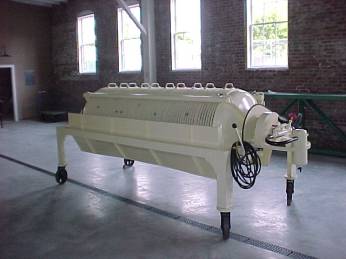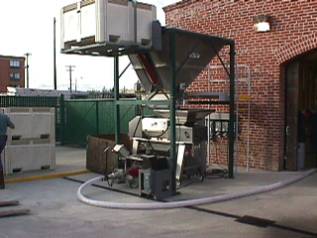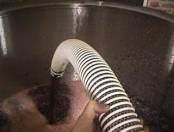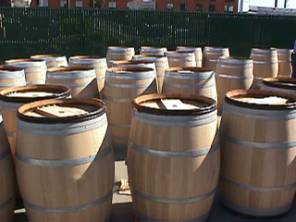Wine Making Process
Winemaking has been around for hundreds of thousands of years. There have definitely been some vast improvements made to the process to make it more successful and the wines taste better.
The two main kinds of wines are white and red. They are made through two different processes, but they start out the same with a sanitizing bath of sulfur dioxide (50-75 ppm). This process is important because it gets rid of any wild yeasts and bacteria that may harm the fermentation process.
Vitis labrusca can be used to make both red and white wines. These grapes do not make as sweet of wine as Vitis vinifera because of the lower glycerol content, which has a direct relationship with the sweetness of a wine. High alanine and choline concentrations may also contribute to the difference in taste of the wine made from Vitis labrusca.5
White Wine
 When
making white wine, the grapes go to the winepress where they are squeezed to
get the pulp separated from the skins and seeds. The skin and seeds are then
allowed to drop to the bottom of the press and get taken out of the juice.
It is then that the yeast, Saccharomyces cerevisiae, gets put in
and the fermentation process begins. The wine gets put into vats where all
of the air gets taken out. This keeps the yeast limited to anaerobic
respiration. It is important that the yeast only goes through anaerobic
respiration because it is through this process that ethanol is produced. The
fermentation process can
When
making white wine, the grapes go to the winepress where they are squeezed to
get the pulp separated from the skins and seeds. The skin and seeds are then
allowed to drop to the bottom of the press and get taken out of the juice.
It is then that the yeast, Saccharomyces cerevisiae, gets put in
and the fermentation process begins. The wine gets put into vats where all
of the air gets taken out. This keeps the yeast limited to anaerobic
respiration. It is important that the yeast only goes through anaerobic
respiration because it is through this process that ethanol is produced. The
fermentation process can take between 10 and 30 days. The temperature of the
fermenting juice needs to stay as close to 25 degrees Celsius so the yeast
does not die. Once fermenting is done, the wine is strained again to get rid
of the dead yeast (the cells will eventually die because they can only
withstand an environment with a certain amount of ethanol in it).
take between 10 and 30 days. The temperature of the
fermenting juice needs to stay as close to 25 degrees Celsius so the yeast
does not die. Once fermenting is done, the wine is strained again to get rid
of the dead yeast (the cells will eventually die because they can only
withstand an environment with a certain amount of ethanol in it).
Red Wine
 After
the initial sanitation, instead of going to the winepress, grapes intended
for red wine production go to the crusher-destemmer. The stems are taken off
the fruit and everything, including the skin and seeds, get crushed to a
pulp that is called a must.
After
the initial sanitation, instead of going to the winepress, grapes intended
for red wine production go to the crusher-destemmer. The stems are taken off
the fruit and everything, including the skin and seeds, get crushed to a
pulp that is called a must.
It then does a cold soak for a few days. This allows the juice to get its color from the grape skins. Then the must is incoculated with Saccharomyces cerevisiae and put into the vats, still with the skins. This lets the wine take on an even better color and take up more of the tannins in the skin.
 The carbon dioxide
pushes the skins to the top of the must and in order to keep the skins in
contact with as much of the liquid as much as possible they pump some of the wine over the top of the vat to
push the cap of skins down into the liquid four times a day. You can
normally tell when the wine is done fermenting because the must goes from
cloudy to clear. It is not until after all of the fermentation takes place
that the liquid is strained away from the skin and seeds.
The carbon dioxide
pushes the skins to the top of the must and in order to keep the skins in
contact with as much of the liquid as much as possible they pump some of the wine over the top of the vat to
push the cap of skins down into the liquid four times a day. You can
normally tell when the wine is done fermenting because the must goes from
cloudy to clear. It is not until after all of the fermentation takes place
that the liquid is strained away from the skin and seeds.
To learn more about how yeast and grapes interact to create wine, click here.
< Interactions & Sustainability Facts >


